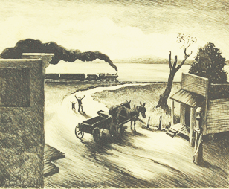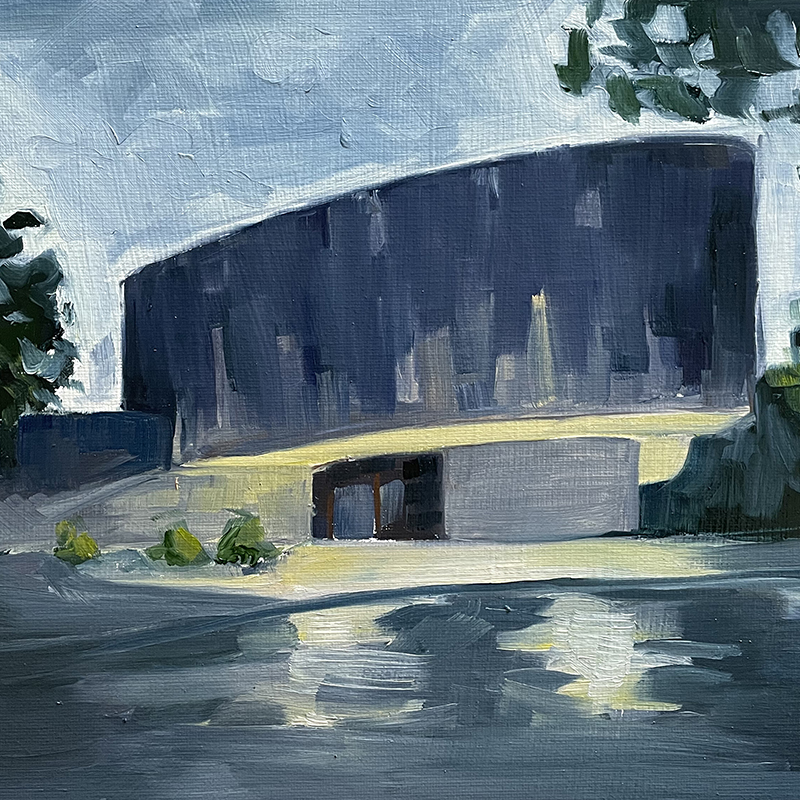New Deal Prints

Thomas Hart Benton,
Untitled (Watching the Train), ca. 1933-43
Prints of the 1930s and 1940s on Loan Courtesy of the U.S. General Services Administration
By the People, For the People
These prints are part of New Deal economic recovery programs (1933 - 1943) that were designed to pull the country out of the Great Depression. During this period, the U.S. government and individual artists worked together towards the idea of stimulating the economy and developing a uniquely American culture. The New Deal art projects represent the largest public art program of their kind in American history, generating energy and excitement when the country was in despair. These prints show the arts as a means of bolstering morale, combating poverty, and creating a common vision for the nation.
For artists, these programs not only provided solid employment, but served to elevate the artist to a professional status while making art accessible to the common person. This exhibition represents two distinct bodies of work; the first includes pastoral or whimsical selections. The second includes depictions that elevated the status of labor, agriculture, production and industry taking place across the country.
In 1934, the federal government began loaning or allocating the portable works of art created under these programs to various public institutions such as museums, libraries, and universities. To date, approximately 14,000 works of art have been identified in museums, libraries, and universities across the United States. These institutions are custodians of the objects for the public trust, utilizing them for educational, scientific, or charitable purposes. In 1949, the Federal Property and Administrative Service Act transferred the functions of the Federal Works Agency, including the management of New Deal art, to the General Services Administration (GSA). Included in the delegated functions is the responsibility of tracking and inventorying the works of art created under the federal government's patronage during the 1930s and 1940s.
The Montana Museum of Art & Culture has participated in the GSA survey of New Deal artworks housed in non-federal repositories. Still serving the purpose of helping to forge a national cultural identity, the New Deal Prints in this exhibition are on permanent loan to MMAC, courtesy of the Fine Arts Program of the General Services Administration in Washington D.C.
During this time, the United States government administered four separate public art programs: the Public Works of Art Project (PWAP), the Federal Art Project (FAP), the Treasury Relief Art Project (TRAP), and the Section of Fine Arts (the Section). These programs were unprecedented in both their size and scope. The thousands of murals, easel paintings, prints, and sculptures created under these federal programs are commonly referred to as Works Progress Administration or ‘WPA' artworks. This classification proves misleading, as only one program, the Federal Art Project, operated directly under the Works Progress Administration. A more accurate classification of the works of art created under the federal art programs of the 1930s and early 1940s is New Deal artwork, as they were created during the era of President Franklin D. Roosevelt's New Deal economic recovery programs. All four of the New Deal art programs created works of art for public use, but differed in their objectives and operations. The characteristics of each program are as follows:
Public Works of Art Project, 1933-1934: The first federal relief program for artists, the PWAP employed almost 4,000 artists who received weekly salaries. When the program ended, over 15,000 works of art had been created, with many of them being lent to government officials and federal agencies, or allocated to public institutions such as orphanages, libraries, schools, and museums.
The Section of Fine Arts, 1934-1943: Originally called the Section of Painting and Sculpture, the Section was administered by the U.S. Treasury Department. The Section's primary objective was to "secure suitable art of the best quality available" for the embellishment of public buildings. Artworks created under the Section were comprised of site-specific murals and sculptures for newly constructed federal buildings and post offices, such as those found in Montana. Unlike the other New Deal art programs, the Section awarded commissions through competitions and paid artists a lump sum for their work. In total, the Section commissioned over 1,300 murals and 300 sculptures.
Treasury Relief Art Project, 1935-1938: Though under the supervision of the Treasury Department, TRAP received funding from the WPA. The funding made it possible for TRAP to provide paintings and sculptures for new federal buildings, in the event that no funds were available from the building appropriation. In addition, TRAP also made possible the decoration of federal buildings that had been erected before the Section came into being. Following similar employment guidelines to those of the WPA, TRAP typically selected artists from relief rolls and paid them a weekly or monthly wage. During its three-year tenure, TRAP employed over 400 artists to create paintings, murals, and sculptures.
Works Projects Administration, Federal Art Project (later called the WPA Art Program), 1935-1942: The FAP was the largest of the New Deal art programs in both its scope and the number of artists employed. In 1939, a massive reorganization of all New Deal relief programs renamed and reduced the program in size. Upon its discontinuation in 1942, the WPA's Federal Art Project and Art Program had produced over 108,000 easel paintings, 11,300 fine prints, 2,500 murals, and 18,000 sculpture works.
